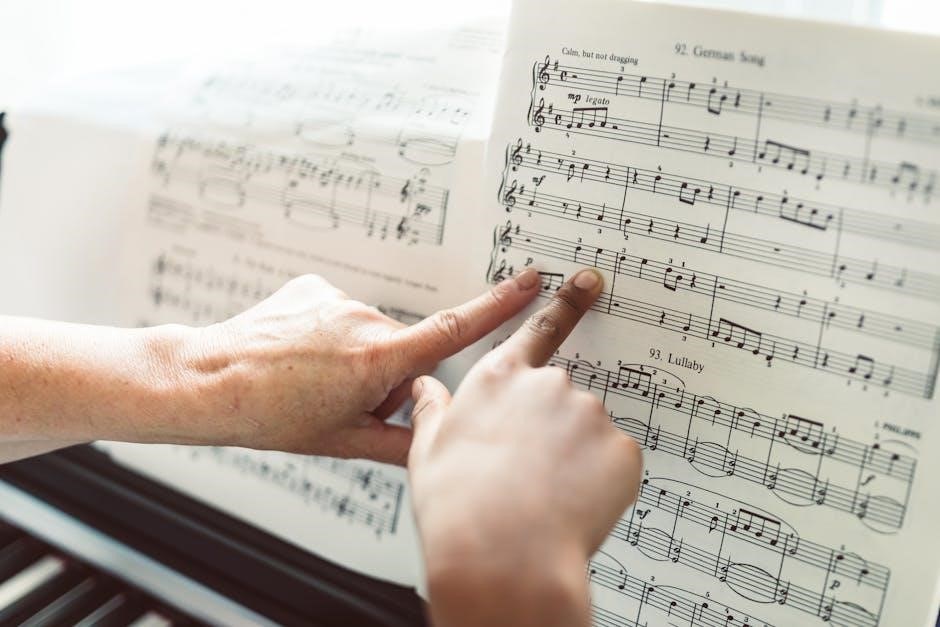Piano chords sheet music is an essential tool for learning and playing effectively. It provides structure, clarity, and access to free, high-quality PDFs from communities like MuseScore and Pianofiles, enhancing your musical journey.
1.1 What Are Piano Chords?
Piano chords are groups of musical notes played simultaneously, creating harmony and depth in music. They are fundamental for pianists, forming the foundation of melodies and accompaniments. Chords can be major, minor, diminished, or augmented, each offering a unique sound. Sheet music simplifies learning by visually representing these chords, allowing pianists to understand note combinations and finger placements. With resources like MuseScore and Pianofiles, accessing chord-based sheet music in PDF format has become effortless, enabling musicians to practice and perform efficiently. Chords are essential for both beginners and advanced players, making sheet music an invaluable tool for mastering piano techniques.
1.2 Importance of Sheet Music in Learning Piano Chords
Sheet music is a vital resource for learning piano chords, providing clear visual representations of notes and finger placements. It helps pianists understand chord structures, timing, and rhythm, making practice more efficient. With sheet music, learners can identify patterns and relationships between notes, which is crucial for mastering chords. Additionally, sheet music often includes chord symbols, enabling musicians to play harmonies and melodies accurately. Access to free PDFs from platforms like MuseScore and Pianofiles ensures that learners can explore a wide range of chords and progressions. Sheet music serves as a foundational tool, guiding pianists from basic chords to complex compositions with precision and clarity.
1.3 Benefits of Using PDF Format for Sheet Music
Using PDF format for sheet music offers numerous advantages, including high-quality visual clarity and consistent formatting across devices. PDFs are easily downloadable and printable, making them accessible for practice and performance. They retain the original layout, ensuring that musical notation is displayed accurately. Additionally, PDFs can be annotated digitally, allowing musicians to mark chord progressions or notes without damaging the original document. Platforms like MuseScore and Pianofiles provide free access to sheet music in PDF format, enabling learners to explore a vast library of chords and compositions. This format is universally compatible, making it a reliable choice for pianists worldwide.

Sources for Free Piano Chords Sheet Music in PDF
Discover free piano chords sheet music in PDF format from MuseScore, Pianofiles, and IMSLP. These platforms offer extensive libraries, easy downloads, and high-quality prints.
2.1 Popular Websites for Downloading Free Sheet Music
Several websites provide free piano chords sheet music in PDF format. MuseScore offers a vast library of user-contributed and professionally created scores. IMSLP boasts a comprehensive collection of classical music sheets. Piano Nanny and 8Notes specialize in chord charts and simplified arrangements. Musicnotes occasionally offers free downloads, including chord-based pieces. These platforms cater to diverse skill levels, ensuring accessibility for beginners and professionals alike. They often feature searchable databases, making it easy to find specific chords or songs. Downloading is typically straightforward, with options for PDF formats that can be printed or viewed digitally.
2.2 MuseScore: A Community-Driven Platform for Sheet Music
MuseScore is a renowned platform offering free and paid sheet music, with a strong focus on community contributions. It features a vast library of piano chord sheets, chord charts, and full scores in PDF format. Users can upload, share, and download sheet music, fostering collaboration among musicians. The platform supports various genres and skill levels, making it ideal for both beginners and advanced players. MuseScore also offers tools for creating and editing sheet music, allowing users to customize chord progressions. Its interactive features, such as playback and notation software, enhance the learning and practice experience for pianists worldwide.
2.3 Pianofiles: A Peer-to-Peer Sheet Music Sharing Website
Pianofiles is a dedicated platform for sharing and accessing piano sheet music, including chord charts and scores in PDF format. It operates on a peer-to-peer model, allowing users to upload and download sheet music freely. The site is known for its extensive collection of piano-related resources, covering various genres and difficulty levels. Pianofiles is particularly popular among pianists seeking rare or hard-to-find sheet music. Its user-friendly interface and robust search functionality make it easy to find specific chord sheets. This platform fosters a sense of community, enabling musicians to share and discover new music while supporting each other’s learning journeys.
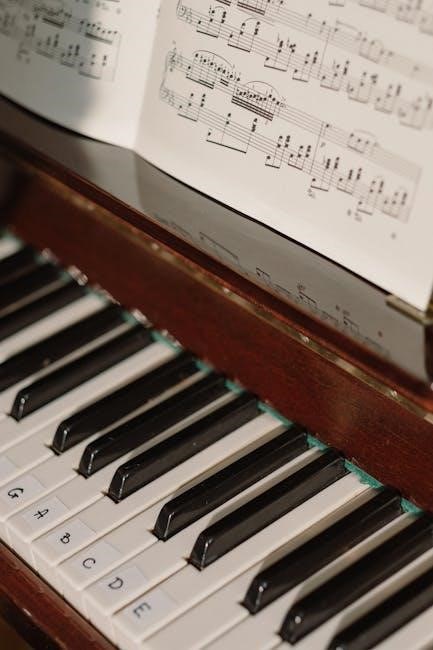
Understanding Piano Chords
Piano chords are groups of musical notes played simultaneously, creating harmonies. They form the foundation of music, influencing mood and structure through their composition and progression.
3.1 Basic Piano Chords for Beginners
Basic piano chords are essential for beginners, providing a foundation for playing and understanding music. Start with C Major (C-E-G), G Major (G-B-D), and their minor counterparts, A Minor (A-C-E) and E Minor (E-G-B). These chords are simple and commonly used in popular songs. Learning D Major (D-F-A) and E Major (E-G-B) follows naturally. Begin by placing fingers on the correct keys and practicing chord transitions smoothly. Focus on finger placement and hand position to ensure clean, clear sounds. Regular practice helps build muscle memory and confidence. Using sheet music in PDF format allows for easy access to chord diagrams and progressions, aiding in learning and mastery.
3.2 Major and Minor Chords: Key Differences
Major and minor chords are foundational in music, with distinct emotional qualities. A major chord consists of a root, major third, and perfect fifth, producing a bright, uplifting sound; For example, C Major is C-E-G. In contrast, a minor chord includes a root, minor third, and perfect fifth, creating a sadder or more introspective tone, as seen in A Minor (A-C-E). The difference lies in the third interval: major chords have a larger gap between the root and third, while minor chords have a smaller one. Understanding this distinction is crucial for playing and interpreting sheet music accurately. PDF resources often highlight these differences with clear diagrams and examples, aiding in practice and comprehension.
3.3 Diminished and Augmented Chords: Advanced Techniques
Diminished and augmented chords add complexity and tension to music. A diminished chord consists of a root, minor third, and diminished fifth, creating a dissonant sound. For example, C Diminished is C-Eb-Gb. Augmented chords, on the other hand, include a root, major third, and augmented fifth, producing a bright yet unstable tone, as in C Augmented (C-E-G#). Both chords are often used in jazz and classical music to create harmonic interest. When reading sheet music, these chords are typically marked with “dim” or “aug.” Practicing these advanced techniques enhances your ability to play complex compositions and expand your musical expression. PDF sheets often provide clear notation for these chords, making them easier to learn and incorporate into your repertoire.
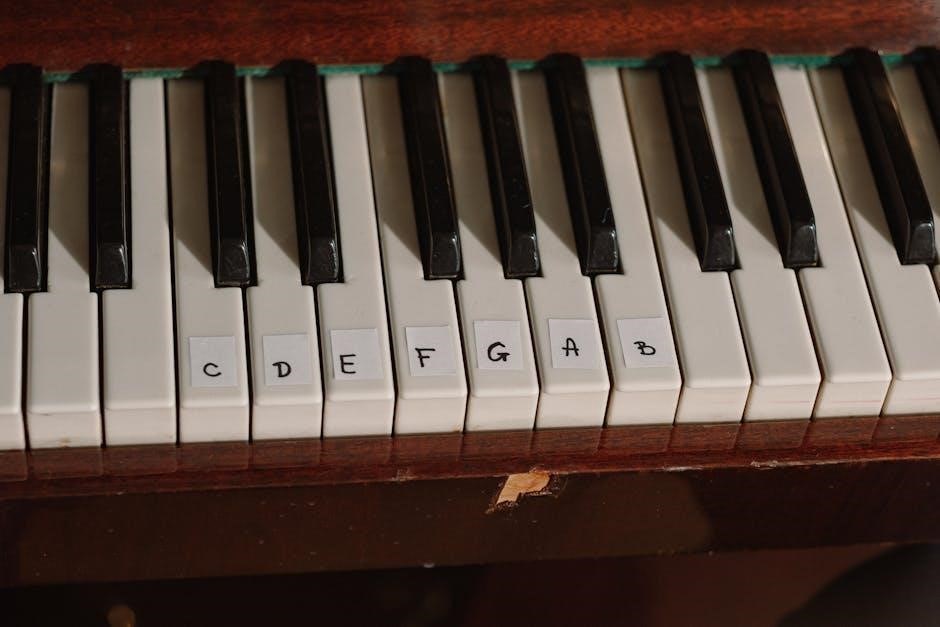
Learning Piano Chords with Sheet Music
Learning piano chords with sheet music in PDF format is an effective way to enhance your skills. Clear layouts and accessibility make it ideal for both beginners and advanced players.
4.1 How to Read Piano Chord Symbols
Reading piano chord symbols begins with understanding the structure of chords. A chord symbol typically consists of a root note and its intervals. For example, a C major chord is represented as C, with the notes C, E, and G. Minor chords are indicated with an “m,” such as Cm. Seventh chords, like C7, add an extra note for depth. Diminished and augmented chords use symbols like ° and +. Practice recognizing these symbols in PDF sheet music to improve your ability to translate them into actual notes on the piano keyboard. Regular practice enhances your sight-reading and playing skills effectively.
4.2 Step-by-Step Guide to Playing Chords from Sheet Music
Start by identifying the chord symbol in the sheet music. Locate the root note on the piano keyboard. Next, determine the notes of the chord based on its type (major, minor, etc.). Place your fingers on the corresponding keys. Play the notes simultaneously to form the chord. Practice each chord slowly to ensure accuracy. Gradually increase your speed as you become comfortable. Use a metronome to improve timing. Repeat the process for different chords, focusing on smooth transitions; Regular practice will help you master playing chords from sheet music effectively and confidently.
4.3 Common Chord Progressions in Popular Music
Common chord progressions are sequences of chords frequently used in popular music. The I-IV-V progression is one of the most widely recognized, often forming the foundation of many songs. For example, in the key of C, this would be C-F-G. Variations like I-V-vi-IV are also prevalent, heard in countless pop and rock tracks. These progressions provide a harmonic structure that listeners find familiar and engaging. Understanding these patterns helps pianists recognize and play along with popular songs more easily. Practicing these progressions enhances musicality and improves chord transitions, making them essential for learners aiming to play contemporary music fluently.

Tools and Resources for Practicing Piano Chords
Explore various tools to enhance your piano chord practice, such as chord-learning apps like Fender Play, video tutorials on YouTube, and software like GarageBand for creating custom exercises.
5;1 Best Apps for Learning Piano Chords
Discover the best apps for mastering piano chords, such as Fender Play, which offers interactive lessons, and Yousician, featuring exercises and games. Piano Maestro provides interactive sheet music, while Simply Piano offers step-by-step lessons. Synthesia helps with chord recognition using MIDI. These apps are perfect for beginners and advanced players, offering personalized learning paths and real-time feedback. They complement PDF sheet music by providing auditory and visual aids, making chord learning engaging and effective. Use these tools to enhance your practice and improve your chord-playing skills efficiently.
5.2 Video Tutorials for Mastering Piano Chords
Video tutorials are an excellent way to visually learn piano chords. Platforms like YouTube offer countless free lessons, such as those by Piano Lessons On The Web and HDpiano. These tutorials provide step-by-step guidance, demonstrating hand placement and chord progressions. Many videos include close-ups of the keyboard, making it easier to follow along. Additionally, paid platforms like MasterClass and TrueFire offer in-depth courses taught by professional pianists. These resources complement PDF sheet music by adding visual and auditory learning elements. They are ideal for beginners and advanced players alike, helping to improve technique and understanding of chord structures.
5.3 Software for Creating and Editing Sheet Music
Software tools like MuseScore, Finale, and Sibelius are essential for creating and editing sheet music. These programs allow users to compose, arrange, and customize piano chord charts with precision. MuseScore is free and user-friendly, making it ideal for beginners, while Finale and Sibelius offer advanced features for professional-grade sheet music. These tools support PDF export, enabling easy sharing and printing. They also allow for real-time playback, helping musicians practice and refine their chord progressions. Additionally, software like Studio One and Logic Pro X integrate chord editing with recording capabilities, offering a comprehensive solution for musicians and composers.
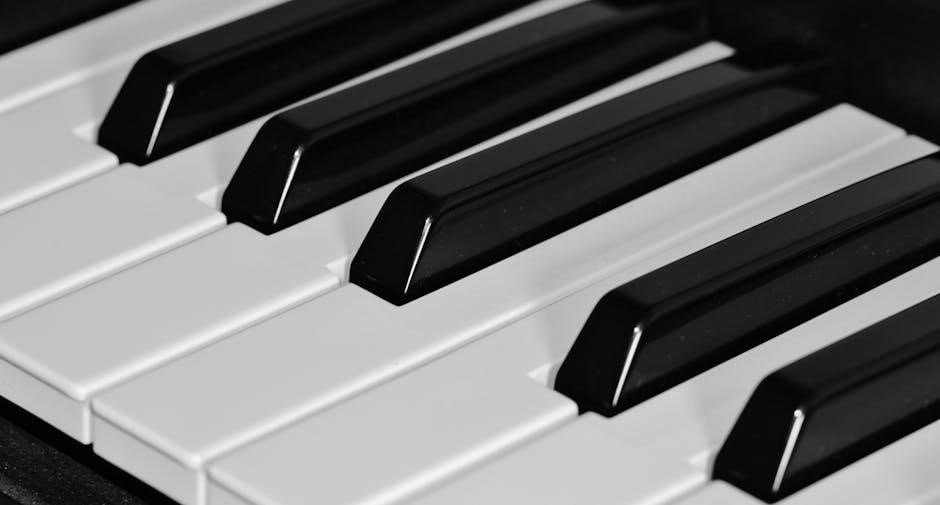
Advanced Techniques in Piano Chords
Mastering advanced techniques like chord inversions, altered chords, and modulation enhances musical expression. These methods expand harmonic possibilities, adding depth and complexity to compositions and performances.
6.1 Inversions and Voicings: Enhancing Your Sound
Inversions and voicings are advanced techniques that elevate your piano playing. Inversions rearrange chord notes, creating unique harmonic textures, while voicings involve spacing notes for emotional depth. By experimenting with these, you can add complexity and expression to your music, making it more engaging. Proper use of inversions ensures smooth chord transitions, while tailored voicings highlight specific melodies or harmonies. These methods are especially useful when working with sheet music, allowing you to interpret chords creatively. Mastering inversions and voicings transforms your sound, making it richer and more professional. They are essential skills for pianists aiming to stand out in their performances.
6.2 Altered Chords: Adding Color to Your Music
Altered chords introduce new dimensions to your music by modifying standard chord structures. These chords, often used in jazz and contemporary styles, incorporate flattened or sharpened notes, such as flat fifths or ninths. They add tension and emotional depth, creating a richer harmonic palette. For example, a C minor chord can become a C minor7b5 for a darker sound. Altered chords are frequently used in improvisation and complex compositions. By incorporating them into your sheet music, you can enhance your arrangements and explore sophisticated musical expressions. This technique is particularly effective for adding color and variety to your performances, making your music more engaging and dynamic.
6.3 Modulation and Key Changes Using Chords
Modulation and key changes are essential techniques for adding depth and variety to music. Chords play a central role in these transitions, as they help establish the tonality of a piece and signal shifts to new keys. A common method involves using pivot chords, which are chords common to both the original and target keys, ensuring a smooth transition. For instance, moving from C major to G major might use an E minor chord as the pivot. Practicing these techniques with sheet music enhances your ability to navigate key changes seamlessly, allowing you to explore diverse musical styles and expand your expressive range.

Community and Collaboration in Piano Music
Collaboration fosters learning and growth among pianists. Online communities and forums provide platforms for sharing sheet music, feedback, and inspiration, motivating musicians to improve and innovate together.
7.1 Online Communities for Piano Enthusiasts
Online communities are vibrant hubs for piano enthusiasts to connect, share, and learn. Forums like Reddit’s r/piano and Facebook groups such as Piano Accompaniment offer spaces for discussing techniques, sharing sheet music, and receiving feedback. These platforms foster collaboration, with members exchanging PDFs of chord charts and participating in challenges. They provide inspiration, support, and motivation, enriching the learning experience. By engaging with fellow pianists, enthusiasts can gain insights and refine their skills in a supportive environment, making these communities invaluable for musical growth.
7.2 Collaborative Sheet Music Projects
Collaborative sheet music projects bring together pianists and musicians worldwide to co-create and refine musical arrangements. Platforms like MuseScore enable real-time collaboration, allowing users to contribute to shared chord charts and compositions. These projects foster creativity, as diverse perspectives lead to unique harmonies and arrangements. Participants can learn from one another, enhancing their understanding of chord progressions and techniques. Collaborative efforts often result in polished, well-structured sheet music that benefits the entire community. Engaging in these projects not only improves musical skills but also builds connections among enthusiasts, making the learning process enjoyable and rewarding.
7.3 Workshops and Classes for Learning Piano Chords
Workshops and classes are excellent resources for mastering piano chords, offering structured learning environments. Many programs focus on chord theory, practical exercises, and application in various musical styles. Group classes provide opportunities for interactive learning, while private lessons offer tailored instruction. Workshops often include hands-on practice, allowing students to improve technique and confidence. These sessions are led by experienced instructors who guide learners through complex chord progressions. Whether for beginners or advanced players, workshops and classes are invaluable for refining skills and deepening understanding of piano chords. They also foster a supportive community where musicians can grow and share their passion for music.

Sight-Reading and Performance Skills
Sight-reading enhances performance skills by improving ability to play unfamiliar music fluently. Regular practice develops muscle memory and confidence, essential for delivering polished, engaging performances.
8.1 Improving Sight-Reading Abilities
Improving sight-reading abilities requires consistent practice with piano chords sheet music in PDF format. Start by practicing unfamiliar pieces regularly to build familiarity with different chord progressions and notations. Break down complex sections into smaller parts and gradually increase speed. Use a metronome to maintain rhythm and timing. Analyze the structure of the music beforehand to identify patterns and chord sequences. Incorporate sight-reading exercises specifically designed to enhance chord recognition and dexterity. Utilize online resources and apps that provide interactive sight-reading drills. Over time, this practice will refine your ability to play confidently and accurately from sheet music.
8.2 Playing Chords Fluently in Real-Time
Mastering real-time chord playing involves refining finger dexterity, hand positioning, and rhythmic accuracy. Regular practice with scales and arpeggios strengthens muscle memory, enabling smooth transitions between chords. Focus on maintaining a steady tempo using a metronome to enhance timing precision. Analyze chord progressions to anticipate shifts, allowing seamless execution. Incorporate dynamic control to maintain consistent volume and expression. Practice sight-reading diverse sheet music to adapt to various styles and tempos. Record sessions to identify and correct errors, ensuring polished performances. Fluency develops through consistent, focused practice, transforming chord playing into a natural, expressive experience.
8.3 Performance Tips for Piano Players
Confidence and stage presence are key to captivating performances. Practice in front of mirrors or record yourself to refine facial expressions and body language. Connect emotionally with the music by focusing on storytelling through dynamics and phrasing. Maintain proper posture to prevent fatigue and ensure technical accuracy. Develop a pre-performance routine, such as deep breathing or warm-ups, to calm nerves. Engage with the audience through eye contact and gestures. Play with intention, emphasizing melody and harmony balance. Stay adaptable to unexpected situations, like chord slips, by recovering smoothly. Most importantly, enjoy the moment, as passion resonates deeply with listeners.
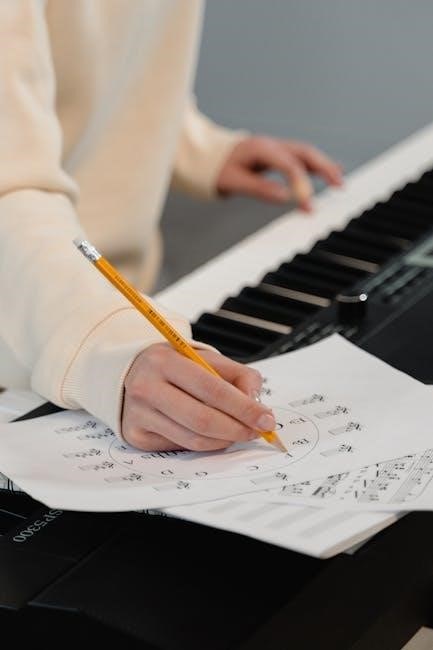
Customizing and Creating Your Own Sheet Music
Customizing sheet music allows personalization of piano chord arrangements, enhancing learning and performance. Utilize software tools to tailor chord charts, transpose keys, and create unique compositions efficiently.
9.1 How to Transcribe Songs into Sheet Music
Transcribing songs into sheet music involves listening to the audio, identifying chords, and notating them. Start by slowing down the track to catch every note and chord progression. Use software like MuseScore or Finale to input the notes. Pay attention to rhythm, timing, and dynamics. Break the song into sections, transcribing verse, chorus, and bridge separately. Ensure accuracy by cross-referencing with tutorials or existing sheet music. Save your work in PDF format for easy sharing and practice. This process enhances your understanding of chord structures and allows you to create personalized sheet music tailored to your learning needs.
9.2 Tools for Generating Custom Chord Charts
Several tools simplify creating custom chord charts for piano music. Software like MuseScore and Finale allow users to input chords, arrange them, and export as PDF. Online platforms such as Chordify can generate chord progressions from audio files, which can then be converted into sheet music. Additionally, apps like GuitarTab or Songsterr provide chord diagrams that can be adapted for piano. These tools enable musicians to create personalized chord charts tailored to their needs, ensuring accuracy and clarity. They are invaluable for learners and composers alike, offering flexibility and customization options for piano chord sheet music in PDF format.
9.3 Sharing Your Sheet Music with the Community
Sharing your custom piano chord sheet music with the community is a great way to connect with fellow musicians and gain feedback. Platforms like MuseScore and Pianofiles allow users to upload and share their creations, fostering collaboration and mutual learning. Additionally, online forums and social media groups dedicated to piano enthusiasts provide spaces to distribute your work. You can also share your PDFs through personal websites or blogs, reaching a broader audience. Sharing not only helps others but also contributes to the growth of the piano community, encouraging improvement and innovation in music creation and performance.

Troubleshooting Common Issues
Troubleshooting issues with piano chords sheet music involves identifying and resolving problems like unclear notation, technical difficulties, or chord misinterpretation. This section provides practical solutions.
10.1 Common Mistakes in Reading Sheet Music
Common mistakes in reading piano chords sheet music include misidentifying note values, ignoring accidentals, and misreading octaves. Beginners often overlook dynamics, tempo markings, and articulations, affecting performance quality. Another error is confusing chord symbols with staff notes. Additionally, neglecting to practice sight-reading can lead to hesitation during playback. To improve, focus on understanding notation basics, such as key signatures and rhythm. Regular practice with sight-reading exercises can enhance accuracy and fluency. Always double-check chord charts for accuracy and ensure proper hand positioning to avoid playing incorrect notes. Mastering these skills will help pianists interpret sheet music confidently and effectively.
10.2 Fixing Technical Difficulties in Playing Chords
Technical difficulties in playing piano chords often stem from poor finger placement, hand positioning, or insufficient practice. To address this, start by slowing down and focusing on accuracy over speed. Use a metronome to improve timing and ensure each note is played cleanly. Break challenging chords into smaller sections and gradually build up. Additionally, strengthen finger independence through exercises like Hanon exercises or scales. Regular practice and patience are key to overcoming technical challenges. Utilize video tutorials or software tools to visualize proper techniques. Consistent practice will help refine your skills and master complex chord progressions with ease and precision.
10.3 Overcoming Challenges in Learning New Chords
Learning new piano chords can be challenging, but persistent practice and strategic approaches can help. Start by breaking chords into smaller parts and gradually combine them. Use a metronome to improve timing and coordination. Focus on hand positioning and finger placement to ensure clarity in sound. Regular practice, even for short durations, reinforces muscle memory. Reviewing sheet music daily helps familiarize yourself with chord structures. Seeking guidance from tutors or online resources can also clarify doubts. Stay motivated by setting achievable goals and celebrating progress. Consistency and patience are key to mastering new chords and enhancing your overall piano skills effectively.
Consistent practice and dedication are key to mastering piano chords. Utilize sheet music resources to enhance your skills and enjoy the rewarding journey of musical growth.
11.1 Summary of Key Points
Learning piano chords with sheet music is essential for building a strong musical foundation. Free PDF resources like MuseScore and Pianofiles offer extensive libraries for practice. Understanding chord basics, such as major, minor, diminished, and augmented chords, is crucial. Advanced techniques like inversions and altered chords can enhance your sound. Tools like apps and software aid in practice, while communities provide support. Consistent practice, sight-reading, and performance skills are vital for mastery. Remember, customization and troubleshooting are part of the journey. Keep exploring, learning, and enjoying the process of mastering piano chords with sheet music as your guide.
11.2 Encouragement for Continuous Practice
Continuous practice is the cornerstone of mastering piano chords. Embrace the journey, and remember that progress, no matter how small, is a step forward. Utilize the wealth of free PDF sheet music and digital tools to make practice engaging and efficient. Set achievable goals, track your progress, and celebrate milestones. Surround yourself with a supportive community to stay motivated. Most importantly, enjoy the process of learning and the joy it brings to create music. Keep practicing, and soon you’ll see significant improvement in your ability to play piano chords with confidence and precision.
11.3 Final Tips for Mastering Piano Chords
To master piano chords, focus on consistency and patience. Break complex chords into smaller parts and practice gradually. Pay attention to finger placement and hand positioning for smooth transitions. Experiment with dynamics and tempo to add depth to your playing. Explore various genres to broaden your chord vocabulary. Leverage piano chords sheet music PDFs for structured learning and practice. Record yourself to track progress and identify areas for improvement. Stay motivated by setting achievable goals and celebrating small victories. Most importantly, embrace the process and enjoy the journey of creating music. Dedication and passion will lead to mastery.
